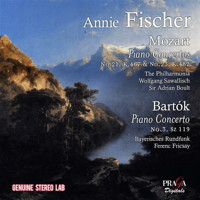
There are several recordings, both audio and video, of Fischer performing the Piano Concerto in C, K 467, by Mozart. The studio recording presented here features her with the Philharmonia Orchestra under a young Wolfgang Sawallisch. The recorded sound is good, although the piano sounds somewhat distant, as if the microphones were placed somewhere around the woodwind. It must be one of the best orchestral accompaniments to this Concerto on record: the ensemble is tight but warm, phrasing is light and graceful, and, possibly because of the placement of the microphones, the ensemble between piano and orchestra, especially the woodwind, is unusually transparent. Fischer herself plays with the characteristics familiar from her other recordings: without being overly intrusive, she shapes phrases in an entirely natural but rhetorical manner, often placing themes into a new light. Articulation and expression are always clear and precise, and her overall view of the Concerto is energetic without ever becoming excessively rhythmical. As in all her other recordings of this work, Fischer plays cadenzas by Busoni for both the first and third movements. As Mozart did not supply any himself, and no other composer has contributed a definitive set in the manner of Beethoven and the D Minor Concerto, pianists are obliged to be more experimental here. Busoni’s cadenzas are clearly stylistically complementary rather than matching, but fulfil all the expectations of what a cadenza should do, albeit with some extra combinations and perhaps more distant modulations than one would anticipate.
The inclusion of these cadenzas underlines the more general problem of concerto
cadenzas: originally intended as spontaneous contributions by the performer,
they have increasingly become predictable parts of the concerto due to the high
quality of the composer’s own cadenzas or those of other specific composers. It
is difficult to justify playing Beethoven’s Fourth Piano Concerto and not to
include one of the two cadenzas Beethoven himself wrote for the first movement,
and so the many interesting and successful cadenzas written by others, such as
Clara Schumann, never get a hearing, not to mention the performer producing one
themselves. The few concertos that do not have an obvious choice, such as this
one, are therefore rare opportunities to be imaginative without being overly
wilful.
The Concerto in A, K 488, is presented in a recording from 1960, also with the
Philharmonia, this time under Sir Adrian Boult. Whilst the orchestral part is
not as perfectly rendered as that in K 467, it is nevertheless very successful.
The piano sound is again somewhat distant, giving the slow movement a little
less impact. Fischer plays this sweetest of Mozart’s Concertos beautifully: it
is as expressive and soulful as it could be without ever crossing the line into
sickliness, a feat not always mastered in this Concerto, even by the greatest
pianists. The slow movement in particular is moving, with genuine pianissimo
throughout, the music restrained and introvert, allowing an unspeakable sadness
to emerge without any trace of melancholia.
Annie Fischer was famous for her performances of Bartok’s Third Piano Concerto,
of which there are three released recordings to date. The version included here
is the second of the three, recorded live in Munich in 1960, with the Bavarian
Radio Symphony Orchestra under Ferenc Fricsay. It is a highly charged,
atmospheric recording, the mystical opening perfectly captured, the serenity of
the second as successful as in the similar movement in Mozart’s K 488, and last
movement fiery and exciting. It is as convincing a recording as any, not
dissimilar to the recording made by Dinu Lipatti and Paul Sacher. Overall, the
recordings included on this CD are all well suited to introduce the virtues of
Annie Fischer to those not acquainted with her playing – repeated listening can
demonstrate the simplicity and vitality she brings to the music, as well as a
sense of genuine profundity.